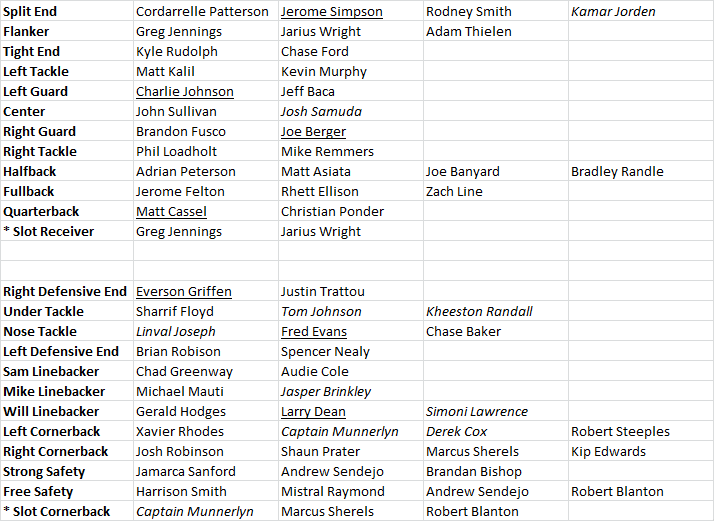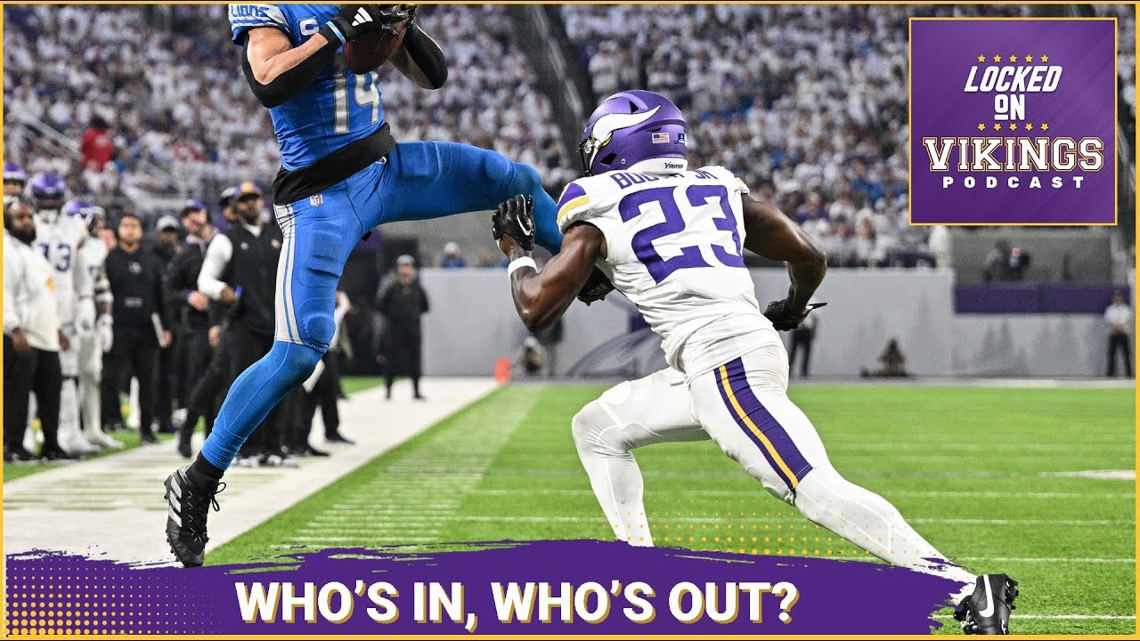Understanding the Vikings Depth Chart

The Vikings depth chart is a crucial tool for understanding the team’s roster and how players are projected to contribute. It Artikels the starting lineup and the backup players for each position, providing insight into the team’s strengths and potential weaknesses.
Vikings Depth Chart Positions
The Vikings depth chart, like all NFL teams, features a wide array of positions, each with their own specific roles and responsibilities. These positions are broadly categorized into offense, defense, and special teams.
- Offense: The offensive side of the ball is responsible for scoring points. Key positions include:
- Quarterback (QB): The leader of the offense, responsible for calling plays and throwing the ball.
- Running Back (RB): Primarily responsible for carrying the ball and running the offense.
- Wide Receiver (WR): Responsible for catching passes from the quarterback.
- Tight End (TE): A hybrid position that combines the duties of a receiver and a blocker.
- Offensive Line (OL): The five players who protect the quarterback and create running lanes for the running backs.
- Defense: The defensive side of the ball is responsible for stopping the opposing offense from scoring. Key positions include:
- Defensive Line (DL): The first line of defense, responsible for pressuring the quarterback and stopping the run.
- Linebacker (LB): Responsible for covering running backs and tight ends, and pressuring the quarterback.
- Defensive Back (DB): Responsible for covering wide receivers and preventing passes from being completed.
- Special Teams: Special teams are responsible for field goals, extra points, punts, and kickoffs. Key positions include:
- Kicker (K): Responsible for kicking field goals and extra points.
- Punter (P): Responsible for punting the ball.
- Long Snapper (LS): Responsible for snapping the ball on field goals, extra points, and punts.
- Returner (KR/PR): Responsible for returning kickoffs and punts.
Current Vikings Depth Chart
The Vikings depth chart for the upcoming season is subject to change, as injuries and player performance can impact the lineup. However, here’s a look at the projected starting lineup and key backups:
| Position | Starter | Backup |
|---|---|---|
| Quarterback | Kirk Cousins | Josh Dobbs |
| Running Back | Dalvin Cook | Alexander Mattison |
| Wide Receiver | Justin Jefferson | Adam Thielen |
| Wide Receiver | K.J. Osborn | Jalen Nailor |
| Tight End | T.J. Hockenson | Irv Smith Jr. |
| Left Tackle | Christian Darrisaw | Blake Brandel |
| Left Guard | Ezra Cleveland | Ed Ingram |
| Center | Garrett Bradbury | Austin Schlottmann |
| Right Guard | Jesse Davis | Josh Ali |
| Right Tackle | Brian O’Neill | Oli Udoh |
| Defensive End | Danielle Hunter | Patrick Jones II |
| Defensive Tackle | Harrison Phillips | Jaren Hall |
| Defensive Tackle | Khyiris Tonga | James Lynch |
| Defensive End | Za’Darius Smith | D.J. Wonnum |
| Linebacker | Eric Kendricks | Jordan Hicks |
| Linebacker | Brian Asamoah II | Troy Dye |
| Linebacker | Blake Lynch | Chazz Surratt |
| Cornerback | Patrick Peterson | Cameron Dantzler |
| Cornerback | Akayleb Evans | Andrew Booth Jr. |
| Safety | Harrison Smith | Josh Metellus |
| Safety | Camryn Bynum | Lewis Cine |
| Kicker | Greg Joseph | None |
| Punter | Ryan Wright | None |
| Long Snapper | Austin Cutting | None |
Analyzing Key Players and Positions: Vikings Depth Chart

The Vikings’ success in the upcoming season hinges on the performance of their key players at each position. Examining the starting lineup and the depth behind them will provide insights into the team’s strengths and weaknesses.
Quarterback
The Vikings have a clear leader at quarterback in Kirk Cousins. Cousins is a seasoned veteran with a proven track record of success, and he brings stability and experience to the offense. However, his performance can be inconsistent, and he sometimes struggles under pressure.
The backup quarterback position is held by Josh Dobbs, who provides a solid option if Cousins is unavailable. Dobbs is a mobile quarterback with a strong arm, but he lacks the experience of Cousins.
Running Back
The Vikings have a dynamic duo in the backfield with Dalvin Cook and Alexander Mattison. Cook is a dynamic playmaker who can break big runs and contribute in the passing game. Mattison is a reliable backup who provides a similar skillset to Cook.
The depth behind Cook and Mattison is a concern. Kene Nwangwu is a talented special teams player, but he is still developing as a running back.
Wide Receiver
The Vikings’ wide receiver corps is a strength. Justin Jefferson is a star wide receiver who is considered one of the best in the league. Adam Thielen is a veteran receiver who provides a reliable target for Cousins.
The Vikings also have a talented young receiver in K.J. Osborn, who has the potential to develop into a key player. However, the depth behind these three receivers is questionable.
Tight End
The Vikings have a reliable tight end in T.J. Hockenson. Hockenson is a strong blocker and a capable receiver who can contribute in both facets of the game.
The backup tight end position is held by Johnny Mundt, who is a solid blocker but lacks the receiving ability of Hockenson.
Offensive Line
The Vikings have a strong offensive line, which is essential for protecting Cousins and creating running lanes for Cook. Christian Darrisaw is a rising star at left tackle, and Brian O’Neill is a consistent performer at right tackle.
The interior of the offensive line is also solid, with Garrett Bradbury at center and Ezra Cleveland and Ed Ingram at the guard positions. The Vikings have good depth on the offensive line, which is crucial for a team that relies heavily on the run game.
Defensive Line
The Vikings have a talented defensive line that is led by the dynamic duo of Danielle Hunter and Za’Darius Smith. Hunter is a relentless pass rusher who can wreak havoc on opposing quarterbacks. Smith is a versatile defensive end who can rush the passer and stop the run.
The Vikings also have a strong interior defensive line with Harrison Phillips and Jaren Hall. However, the depth behind these players is a concern.
Linebacker
The Vikings have a solid linebacker corps, with Jordan Hicks and Eric Kendricks leading the way. Hicks is a veteran linebacker who is a reliable tackler and playmaker. Kendricks is a talented coverage linebacker who can disrupt opposing offenses.
The Vikings have a solid backup linebacker in Troy Dye, but the depth behind him is a concern.
Defensive Back, Vikings depth chart
The Vikings have a strong secondary that is led by Patrick Peterson and Harrison Smith. Peterson is a veteran cornerback who is a lockdown defender. Smith is a talented safety who is a leader on the defense.
The Vikings also have a talented young cornerback in Cam Dantzler, who has the potential to develop into a star. However, the depth behind these players is a concern.
Factors Influencing Depth Chart Changes

The Vikings depth chart is not set in stone and can change frequently throughout the season. Several factors can influence these changes, reflecting the dynamic nature of professional football.
Impact of Injuries
Injuries are an inevitable part of football, and they can significantly impact the depth chart. When a key player gets injured, it forces coaches to rely on backup players who may not have as much experience. For example, if the starting quarterback goes down, the backup quarterback will step in, potentially leading to a shift in offensive strategies. This can also lead to opportunities for younger players to prove themselves and potentially earn a starting role.
The Vikings depth chart at wide receiver is in a state of flux, with the departure of Adam Thielen leaving a significant void. However, the team is hoping for a breakout season from K.J. Osborn, and they’ll be looking for production from the likes of Jalen Nailor and Justin Jefferson.
The Vikings are hoping that Jefferson’s success can help to elevate the entire receiving corps and make the Vikings offense a formidable force in 2023.
The Vikings’ depth chart has taken a hit with the recent injury to starting linebacker, Jordan Hicks. While Hicks’ absence is significant, the Vikings are hoping to rely on the experience of veteran Eric Kendricks, who has a history of solid play.
However, the team might need to consider other options, especially if the injury is severe, like a Gibbs injury , which can significantly impact a player’s recovery time. The Vikings’ defensive coordinator will need to strategize to maintain their defensive strength, potentially relying on younger players to step up in Hicks’ absence.
